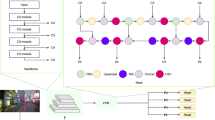Abstract
Sensors are the quintessential part of Blind Spot Detection (BSD) systems, which have a profound effect on the performance of the system. Every sensor has its unique deficiencies that can deteriorate the performance of the system under grievous circumstances. Hence, making vital tasks in BSD such as object detection arduous. Indeed, previous studies have demonstrated that data fusion techniques can diminish the adverse effects of sensors and improve detection accuracy in the BSD system. One of the main advantages of data fusion is to improve detection accuracy and reduce the processing time by multiple sensors cooperation. We propose a BSD model that objects are detected in consecutive time intervals in the BSD system. Then, association techniques are employed for multi-sensor fusion since all sensors data are not ordinarily ready for fusion simultaneously. It should be noted that the orthodox approach in data association techniques in BSD often includes a global nearest neighbor, joint probabilistic data association, and multiple hypothesis tests. We simulate and compare these techniques by tracking multiple targets and multi-sensor fusion using virtual data in MATLAB. Furthermore, we illustrate that our multi-sensor fusion detection accuracy in the BSD system is augmented compared to a single sensor BSD system.
















Similar content being viewed by others
References
Mukhtar, L.X., Tang, T.B.: Vehicle detection techniques for collision avoidance systems: A review. IEEE Trans. Intell. Trans. Syst. 16(5), 2318–2338 (2015)
Baustista, D.G.: Functional architecture for automated vehicles trajectory planning in complex environments, Automatic. PSL Research University (2017)
Felix: Sensor set design patterns for autonomous vehicles. (2019) [Online]. Available: https://autonomous-driving.org/2019/01/25/positioning-sensors-for-autonomous-vehicles/
Sattar, F., Karray, F., Kamel, M., et al.: Recent advances on context-awareness and data/information fusion in ITS. Int. J. ITS Res. 14, 1–19 (2016). https://doi.org/10.1007/s13177-014-0097-9
Moshiri, B., Eydgahi, A.M., Hoseinnezhad, R., Najafi, M.: Multi-sensor data fusion used in intelligent autonomous navigation. IASTED CA’99 (Control and Applications) Banff Canada (1999)
Gale Bagi, S.S., Garakani, H.G., Moshiri, B., and Khoshnevisan, M.: Sensing structure for blind spot detection system in vehicles. 2019 International Conference on Control, Automation and Information Sciences (ICCAIS), Chengdu, China, 1–6 (2019). https://doi.org/10.1109/ICCAIS46528.2019.9074580
Dooley, D., McGinley, B., Hughes, C., Kilmartin, L., Jones, E., Glavin, M.: A blind-zone detection method using a rear-mounted fisheye camera with combination of vehicle detection methods. IEEE Trans. Intell. Transp. Syst. 17(1), 264–278 (2016)
Lin, B.-F., et al.: Integrating appearance and edge features for sedan vehicle detection in the blind-spot area. IEEE Trans. Intell. Transp. Syst. 13(2), 737–747 (2012)
Baek, S., Kim, H., Boo, K.: Robust vehicle detection and tracking method for blind spot detection system by using vision sensors. 2014 Second World Conference on Complex Systems (WCCS) (2014)
Wu, B.-F., Kao, C.-C., Li, Y.-F., Tsai, M.-Y.: A real-time embedded blind spot safety assistance system. Int. J. Veh. Technol. 2012, 506235, 15 (2012). https://doi.org/10.1155/2012/506235
Zhao, Y., Bai, L., Lyu, Y., Huang, X.: Camera-based blind spot detection with a general purpose lightweight neural network. Electronics 8, 233 (2019)
Guo, Y., Kumazawa, I., Kaku, C.: Automot. Innov. 1, 362 (2018). https://doi.org/10.1007/s42154-018-0036-6
Ester, M., Kriegel, H.-P., Sander, J., Xu, X.: A Density-based algorithm for discovering clusters in large spatial databases with noise. Proc. 2nd Int. Conf. on Knowledge Discovery and Data Mining, Portland: AAAI Press, 226-231 (1996)
Schubertm E., Meinl, F., Kunert, M., Menzel, W.: Clustering of high-resolution automotive radar detections and subsequent feature extraction for classification of road users. In 16th International Radar Symposium (IRS), Dresden, 174-179 (2015)
Chavez-Garcia, R.O., Aycard, O.: Multiple sensor fusion and classification for moving object detection and tracking. IEEE Transactions on Intelligent Transportation Systems, IEEE, PP(99), 1-10 (2015)
Kim, S., Kim, H., Yoo, W., Huh, K.: Sensor fusion algorithm design in detecting vehicles using laser scanner and stereo vision. IEEE Trans. Intell. Transp. Syst. 17(4), 1072–1084 (2016)
Park, M.W., Jang, K.H., Jung, S.K.: Int. J. ITS Res. 10, 101 (2012). https://doi.org/10.1007/s13177-012-0046-4
Cho, H., Seo, Y., Kumar, B.V.K.V., and Rajkumar, R.R.: A multi-sensor fusion system for moving object detection and tracking in urban driving environments. 2014 IEEE International Conference on Robotics and Automation (ICRA), Hong Kong, 1836-1843 (2014)
Wang, X., Xu, L., Sun, H., Xin, J., Zheng, N.: On-road vehicle detection and tracking using MMW radar and monovision fusion. IEEE Trans. Intell. Transp. Syst. 17(7), 2075–2084 (2016)
Ghahroudi, M.R. and Sabzevari, R.: Multisensor data fusion strategies for advanced driver assistance systems, sensor and data fusion, Nada Milisavljevic, IntechOpen (2009). https://doi.org/10.5772/6575. Available from: https://www.intechopen.com/books/sensor_and_data_fusion/multisensor_data_fusion_strategies_for_advanced_driver_assistance_systems
Castanedo, F.: A review of data fusion techniques. Sci. World J. 2013, 704504 19 (2013). https://doi.org/10.1155/2013/704504
Blackman, S.S.: Multiple hypothesis tracking for multiple target tracking. IEEE Trans. Aerospace and Electronic Systems 19, 5–18 (2004)
Forkenbrock, G., Hoover, R.L., Gerdus, E., Van Buskirk, T.R., & Heitz, M.: Blind spot monitoring in light vehicles — System performance. (Report No. DOT HS 812 045). Washington, DC: National Highway Traffic Safety Administration (2014)
Buller, W., Wilson, B., Garbarino, J., Kelly, J., Subotic, N., Thelen, B., & Belzowski, B.: Radar congestion study (Report No. DOT HS 812 632). Washington, DC: National Highway Traffic Safety Administration (2018)
Blind Spot Assist Vehicle Safety Technology — Mercedes-Benz 2013 ML-Class. Youtube: Mercedes-Benz USA (2012)
Author information
Authors and Affiliations
Corresponding author
Additional information
Publisher's Note
Springer Nature remains neutral with regard to jurisdictional claims in published maps and institutional affiliations.
Rights and permissions
About this article
Cite this article
Shirahmad Gale Bagi, S., Moshiri, B., Gharaee Garakani, H. et al. Blind Spot Detection System in Vehicles Using Fusion of Radar Detections and Camera Verification. Int. J. ITS Res. 19, 389–404 (2021). https://doi.org/10.1007/s13177-021-00254-5
Received:
Revised:
Accepted:
Published:
Issue Date:
DOI: https://doi.org/10.1007/s13177-021-00254-5




